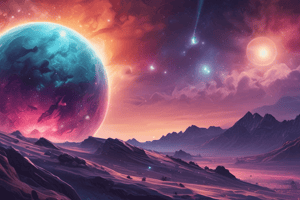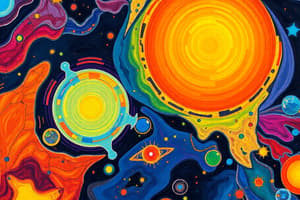Podcast
Questions and Answers
What happens when a star runs out of fuel and cannot fuse iron into a heavier element?
What happens when a star runs out of fuel and cannot fuse iron into a heavier element?
- The star expands into a red giant.
- The star undergoes a supernova explosion. (correct)
- The star becomes a black hole.
- The star dissipates into dust.
A pulsar is a type of neutron star that has a weak magnetic field.
A pulsar is a type of neutron star that has a weak magnetic field.
False (B)
What is the remnant of a star after a supernova explosion?
What is the remnant of a star after a supernova explosion?
neutron star
A magnetar has a magnetic field that can be __________ times stronger than a typical neutron star's magnetic field.
A magnetar has a magnetic field that can be __________ times stronger than a typical neutron star's magnetic field.
Match the following types of neutron stars with their characteristics:
Match the following types of neutron stars with their characteristics:
How do astronomers typically observe neutron stars?
How do astronomers typically observe neutron stars?
Neutron stars are easily viewable with backyard telescopes.
Neutron stars are easily viewable with backyard telescopes.
What triggers the explosion known as a supernova?
What triggers the explosion known as a supernova?
What is the estimated number of asteroids larger than 1 kilometer in the belt?
What is the estimated number of asteroids larger than 1 kilometer in the belt?
Earth trojans are more numerous than Jupiter trojans.
Earth trojans are more numerous than Jupiter trojans.
What are the two special points called where trojan asteroids gather?
What are the two special points called where trojan asteroids gather?
The gas in interstellar clouds is primarily composed of __________ and __________.
The gas in interstellar clouds is primarily composed of __________ and __________.
Match the following terms with their descriptions:
Match the following terms with their descriptions:
What is the primary focus of cosmochemistry?
What is the primary focus of cosmochemistry?
Geochemists aim to understand geochemical cycles and their future alterations.
Geochemists aim to understand geochemical cycles and their future alterations.
What phenomenon indicates that the universe is expanding?
What phenomenon indicates that the universe is expanding?
The Big Bang is a model for the universe's evolution that began in a ______ state.
The Big Bang is a model for the universe's evolution that began in a ______ state.
Match the following concepts with their definitions:
Match the following concepts with their definitions:
Which element of Einstein's theory demonstrates the link between space and time?
Which element of Einstein's theory demonstrates the link between space and time?
According to modern cosmology, the universe has both an edge and a center.
According to modern cosmology, the universe has both an edge and a center.
What are the two fundamental phenomena that indicate the occurrence of the Big Bang?
What are the two fundamental phenomena that indicate the occurrence of the Big Bang?
What type of stars make up around 90% of the universe's stellar population?
What type of stars make up around 90% of the universe's stellar population?
Sirius is the closest main sequence star that can be seen by the naked eye.
Sirius is the closest main sequence star that can be seen by the naked eye.
What process occurs in the core of main sequence stars?
What process occurs in the core of main sequence stars?
A star that has a mass less than eight times the Sun's mass becomes a __________ when it runs out of hydrogen in its core.
A star that has a mass less than eight times the Sun's mass becomes a __________ when it runs out of hydrogen in its core.
How do red giants form?
How do red giants form?
Match the following stars with their characteristics:
Match the following stars with their characteristics:
Main sequence stars can live for millions to billions of years.
Main sequence stars can live for millions to billions of years.
What elements are fusing when a main sequence star evolves into a red giant?
What elements are fusing when a main sequence star evolves into a red giant?
Who presented the entire theory of nucleosynthesis?
Who presented the entire theory of nucleosynthesis?
Hydrogen and helium are the least abundant elements in the solar system.
Hydrogen and helium are the least abundant elements in the solar system.
What is the approximate atomic hydrogen to helium ratio in the solar system?
What is the approximate atomic hydrogen to helium ratio in the solar system?
The abundances of elements having atomic numbers greater than __ have no stable isotopes.
The abundances of elements having atomic numbers greater than __ have no stable isotopes.
Match the following elements with their characteristics:
Match the following elements with their characteristics:
Which of the following statements is consistent with the Oddo-Harkins rule?
Which of the following statements is consistent with the Oddo-Harkins rule?
Technetium and promethium are stable isotopes found abundantly in the solar system.
Technetium and promethium are stable isotopes found abundantly in the solar system.
The abundances of the first 50 elements decrease __.
The abundances of the first 50 elements decrease __.
Flashcards are hidden until you start studying
Study Notes
Stellar Evolution
- Neutron stars form when a supernova explosion occurs, as the core collapses and rebounds, creating a superdense remnant.
- Pulsars are rapidly rotating neutron stars with bright X-ray hot spots that appear as rotating beams, similar to a lighthouse.
- Magnetars have exceptionally strong magnetic fields, millions of times stronger than typical neutron stars and far more powerful than common magnets.
- Neutron stars are not visible to the naked eye; they are primarily studied through X-ray and radio emissions.
Cosmochemistry
- Cosmochemistry examines the chemical composition of matter in the universe and its formation processes.
- Goals of geochemistry include understanding the distribution of elements on Earth and the solar system, chemical reactions on Earth's surface and interior, and the assembly of geochemical cycles.
Origin of the Universe
- The universe is thought to have originated approximately 13.7 billion years ago in the event known as the Big Bang, characterized by a hot, dense state that expanded and cooled.
- Modern cosmology posits that the universe has no edge or center, and both space and time began at the moment of the Big Bang.
- Evidence for the Big Bang includes the observable expansion of the universe and the presence of cosmic background radiation.
Asteroids and the Solar System
- Trojans are asteroids that share an orbit with a planet, concentrated around L4 and L5 Lagrangian points, with Jupiter trojans being a significant population.
- Asteroids can impact planets, leaving meteorite records on their surfaces.
Interstellar Medium
- The interstellar medium consists of gas clouds primarily made of hydrogen and helium from the universe's early expansion, combined with elements formed in earlier stars.
- These gas and dust clouds can collapse to form new stars, influenced by their mass and composition.
Types of Stars
- Main sequence stars constitute about 90% of stellar populations and fuse hydrogen into helium, varying in mass from 0.1 to 200 times that of the Sun.
- Red giants, which develop when main sequence stars exhaust hydrogen, expand as helium fuses into carbon, leading to core temperature and pressure increases.
Nucleosynthesis
- The B2FH theory explains the origin of chemical elements in stars, detailing how different masses and compositions yield varying element abundances.
- Hydrogen and helium are the most abundant elements in the solar system, with a H/He ratio of about 12.5.
- The abundance of elements decreases exponentially with atomic number; even atomic numbers tend to have higher abundances than their neighboring odd-numbered elements (Oddo-Harkins rule).
- Elements like lithium, beryllium, and boron are found in low abundances, whereas iron is more prevalent than elements with similar atomic numbers.
- Technetium and promethium do not naturally occur due to the instability of their isotopes, while elements beyond atomic number 83 have no stable isotopes and are present at low abundances.
Studying That Suits You
Use AI to generate personalized quizzes and flashcards to suit your learning preferences.




